By Thomas Johnson
With the military buildup back on the horizon bringing more opportunities within view, the good times in the construction industry just may be back sooner than expected. But while contracting opportunities exist and the future looks bright on Guam, companies still have concerns.
Some are concerned about project pricing. Some are concerned about the stability of military growth. Some are concerned about finding adequate skilled labor to meet demand. And there is one thing that all key players can agree on: Competition will be fierce.
“Our initial projection was that 2015 would be a slower year than this year,” says James A. Martinez, president of the Guam Contractors Association. “However, with the [Aug. 16] news of the Pentagon submitting the Buildup Master Plan to the House and Senate Armed Services Committee, this will pave the way for the release of about $1 billion in Japanese government funds already deposited in the U.S. Treasury specifically for projects associated with the transfer of U.S. Marines from Okinawa to Guam.”
Martinez also says that GCA is awaiting the Record of Decision in early 2015 that will give the green light for the construction of further facilities associated with the buildup realignment.
Black Construction Corp.’s outlook for the island’s construction industry for the remainder of 2014 and 2015 is also positive, according to Leonard K. Kaae, senior vice president and general manager for Black Construction. “There have been a number of military projects bid and awarded in 2014, and several proposals have been submitted with results pending. We’re also currently preparing proposals for large projects, including two additional hangars at Andersen Air Force Base.” Kaae adds that, as the pace of military construction picks up, Black Construction expects to see an increase on the private side of the construction industry as well.
“We’re very optimistic,” he says. “The military buildup will provide greater opportunities to the local workforce, including those at the entry level that want to learn a trade through the apprenticeship program. There are significant small-business requirements on military construction projects, providing expanding opportunities for entrepreneurs that would like to start a small business. We’ve been gearing up for the buildup for a number of years.”
Kaae said the buildup will also bring opportunities to the government of Guam through revenues generated from increased GRT paid by contractors and additional income taxes paid by a growing workforce.
Theron C. Holloway and Louis C. DeMaria, senior vice president/general manager and vice president of dck Pacific Guam LLC, respectively, have cautious optimism about the buildup and agree that an increase on the private side of the industry is imminent. “There is a little bit of a lull military-wise,” Holloway says, “And I think next year’s [military construction] money is definitely going to come slower than it has. So we see the next year as being a little bit questionable, but we see 2016 as being a time of greater opportunity.”
Also factoring into the equation, DeMaria adds, is the Mamizu funding from the Japanese government. “If that gets released, that’s another $1.5 billion worth of military projects available, but they haven’t indicated when it’s going to be released. So that probably means a slowdown for next year. This year was very good for us — I would say somewhere in the neighborhood of $650 million to $700 million — but next year, it’s starting to look more like $150 million. That’s why we’re hoping the Mamizu money starts to flow, but even if military spending slows next year, the commercial market seems to be growing as well because of it. And with the commercial and public works markets picking up, that affords us more opportunities, too.”
Smithbridge Guam Inc. is adopting a careful stance in the face of the renewed military buildup, but Stevyn J. Radonich, the company’s vice president, adds that the company is harboring high hopes for 2015. “There is a group of projects that have already been bid on and are slated for construction in 2015,” Radonich says, “And there are many more presently bidding, so 2015 should see a busy year for Guam in construction. The military buildup — or as I would prefer to call it, “strategic realignment” — is still not a given, but at least it now appears to be moving in the right direction again.”
However, Radonich says that the promise of hope is still not enough to convince Smithbridge to place too many of its eggs in the military buildup basket. “There is still opposition against the buildup out there, and if it proves too difficult for the military to gain any forward momentum, any potential buildup plans could have a high chance of stalling or fading out entirely.”
Not all of the island’s contractors are hedging their bets when it comes to the potential military construction opportunities on the horizon. “We talk of the pending military buildup, but there’s already a significant level of [Department of Defense] construction spending on Guam,” says John Sage, vice president of Watts Constructors. Sage says that programs unrelated to the buildup, such as Pacific Air Resiliency, are very active, and Watts has picked up a substantial amount of backlog from that, with more on the immediate horizon. In the face of other contractors’ cautionary stance on the buildup, Sage’s confidence in military spending stands out but is no surprise.
As part of the Guam MACC Builders joint venture, Watts — along with partners Obayashi Corp. of Japan and Webcor Builders of California — has already acquired several multiple-award construction contracts, or MACCs, for the months to come.
Jerrold C. “Jere” Johnson, president of Hawaiian Rock Products, is also highly optimistic about the buildup. “Very much so,” he says, adding that the remainder of 2014 will bring a lull that he expects to lead into a far more active period in 2015. “There aren’t a whole lot of projects this year, but there are several large projects next year, and the bigger ones haven’t been awarded yet. So we’re just waiting to see who the winning contractors will be and how soon they plan to start. It’s been a better year for some than for others, but that’s just the nature of the business.”
As a supplier of building materials and aggregate for many of the projects being worked on around the island, Johnson says that Hawaiian Rock is fortunate enough to have been selected to provide concrete and aggregate products for several projects, in addition to providing secondary related services, such as asphalt paving.
While all of the companies have managed to improve their outlook on the future since the bottom fell out from underneath the buildup several years ago, they don’t see challenges disappearing anytime soon.
“Like our counterparts throughout the nation, Guam contractors also have a challenge of a lack of a skilled workforce in construction to meet our current and future demand,” Martinez says. “Our biggest challenge is that not too many people are interested in construction for whatever reason. Long-time construction craftsmen, who are probably on their way to retirement, once said that construction work used to be a sexy occupation, and indeed, many people back in the ‘60s, ‘70s and even the ‘80s worked in construction.”
Having talked with many local contractors regarding the labor shortage, Martinez says that while many of them have not employed foreign H2 workers since the 1970s, they may be forced to do so in the near future. “With the scope of work and the dollar amounts of some of these new projects, they have indicated that they will need to bring in foreign labor to do the jobs,” he says, noting that it will be much more expensive in the long run to house and feed the H2 workers than it will be to train local talent.
“Contractors would prefer using the local workforce in order to remain competitive in the market, but they also realize there is, or will be, a shortage of construction-skilled labor,” Martinez says. “They would like to hire more locals for this work and provide training for them, but the pipeline for those entering the industry — and even for those remotely interested in the industry — is drying up.”
Martinez adds that the Guam Contractors Association is working on outreach programs to entice more people into the industry. “We’ve been working on programs and events that give young students hands-on experience in construction,” he says. According to Martinez, one of the organization’s big pushes this year is to reach out to middle and high school aged females to consider careers in construction through seminars like the annual Pizza, Pop and Power Tools event, which gives young women the opportunity to learn to operate the tools of the trade.
Kaae says the skilled labor shortage will affect both the military and private construction markets, and the company is in the process of adding to its workforce of 370 local craftsmen. “We expect our workforce to grow considerably and are actively hiring skilled labor now,” Kaae says.
However, Kaae adds that while the company’s primary focus will be in hiring locally, due to the significant increased skilled labor demand within the construction industry as a whole, Black Construction believes it may be necessary to bring in H-2B temporary resident workers. “Adequately addressing the increased labor demand will be a challenge not only to [Black Construction], but to the industry as a whole,” he says.
Project~ Vendor~ Estimated cost~ Award Date~ Completion Date
DPW – Reconstruction of Pale San Vitores Road~ Maeda Pacific Corp.~ $1.8 million~ 1/4/2010~ 9/30/2015
DPW – Route 3 Widening Route 28 to Chalan Kareta~ SSFM International Inc.~ $2.2 million~ 5/9/2011~ 9/30/2014
Plaza de Espana Restoration~ Reliable Builders Inc.~ $1.3 million~ 9/30/2012~ 9/30/2014
DPW – Route 4 Agfayan Bridge Replacement~ Black Construction Co.~ $4.7 million~ 6/4/2013~ 11/12/2014
Phase II GU Chamorro Education Building~ Inland Builders Corp.~ $15.8 million~ 8/9/2013~ 9/30/2014
DPW – Route 17 Rehab & Widening, Phase 2A~ Nippo Corp.~ $2.6 million~ 10/25/2013~ 9/30/2014
DPW – Ordot Dump Closure – Construction and Dero Road Sewer Improvements~ Black Construction Co.~ $40.5 million~ 12/6/2013~ 12/6/2015
DPW – Inarajan Northleg Bridge Rehab~ IMCO General Construction Inc.~ $1.2 million~ 3/6/2014~ 3/6/2015
DPW – Routes 26 and 25 Intersection Improvements~ Korando Corp.~ $2.5 million~ 3/6/2014~ 11/1/2014
DPW – Tiyan Parkway Phase I Project~ IMCO General Construction Inc.~ $7.3 million~ 3/10/2014~ 3/10/2015
NAVFAC Marianas – AAFB BAMS Hangar MACC~ Guam MACC Builders~ $45.4 million~ 3/27/2014~ 4/1/2016
NAVFAC Marianas – IDIQ Construction, Navy Support Facility, Diego Garcia, BIOT~ Black Construction Co.~ $10 million~ 4/7/2014~ 5/1/2014
NAVFAC Marianas – Emergent Repair Facility~ MACC Guam MACC Builders~ $25.7 million~ 4/11/2014~ 5/1/2016
Const. Farmers Coop Facility and Relocation – Dededo Flea Market~ Mega United Corp.~ $2.5 million~ 5/1/2014~ 3/28/2015
NAVFAC Marianas – Marine Corps Support and Maintenance Hangar MACC~ Dck Pacific~ $53.7 million~ 5/7/2014~ 12/1/2016
NAVFAC Marianas – Modular Storage Construction & Infrastructure Improvements MACC~ Guam MACC Builders~ $42.3 million~ 5/12/2014~ 6/1/2016
DPW – Bile/Pigua Bridge Replacement Project~ Korando Corp.~ $3.7 million~ 6/10/2014~ 9/3/2015
Guam Public Library – Extension, Design-Build~ S.K. Construction Inc. & Giant~ $1 million~ 7/14/2014~ 7/9/2015
NAVFAC Marianas – IDIQ Airfield Paving~ Hawaiian Rock Products Corp.~ $90 million~ 8/1/2014~ TBD
NAVFAC Marianas – Guam Strike Fuel Systems Maintenance Hangar~ TBD~ $131.5 million~ 9/30/2014~ TBD
NAVFAC Marianas – Par-Pol Fuel Systems Hardened Structures~ TBD~ $20 million~ 9/30/2014~ TBD
NAVFAC Marianas – PRTC Red Horse Logistics Facility~ TBD~ $3.2 million~ 2/11/2015~ TBD
NAVFAC Marianas – PRTC Satellite Fire Station~ TBD~ $6.5 million~ 2/25/2015~ TBD
NAVFAC Marianas – Composite Repair Shop~ TBD~ $39.6 million~ 3/18/2015~ TBD
NAVFAC Marianas – PRTC – Combat Communications Infrastructure~ TBD~ $4.3 million~ 4/16/2015~ TBD
NAVFAC Marianas – DPRI-GSE Shops at North Ramp~ TBD~ $21.9 million~ 9/4/2015~ TBD
NAVFAC Marianas – DPRI – MWSS Facilities at North Ramp~ TBD~ $28.8 million~ 9/4/2015~ TBD
[/table] Sources: Department of Public Works and Naval Facilities Engineering Command Marianas
Dck Pacific is less concerned with labor issues but that the market will grow more competitive as opportunities continue to develop. “I think in the year ahead, I don’t see competition backing down anytime soon,” Holloway says. “I think that opportunities are going to be hard-won. But work in general is tough these days, and at times, it wears on you. But it also provides people like us with the best opportunity to succeed because we’re used to operating in tough environments.”
DeMaria adds, “The prices are tighter and the margins are tighter, but I think a lot of that is just what happens when we go through a period like we have — when there just wasn’t much work to go around. And now it looks like we’re starting to come out of that, but whether or not it continues this trend, we’ll just have to see. Things change fast.”
Aggressive pricing is becoming a greater challenge for Hawaiian Rock as well, Johnson says, as contractors’ lower bids for projects ultimately translates to a greater need for cost-efficiency in terms of its materials. “There’s a lot of competition among the subcontracting people and suppliers to get that work, so it’s compressing all the pricing on projects. It’s not a very lucrative construction market right now. But we’re hoping that as everyone gets busy and the work is more abundant, pricing will start to go up again,” he says.
Hawaiian Rock has been combatting pricing challenges by gradually reducing its workforce in order to cut expenses and remain competitive. However, he holds out hope that the rise in construction projects will mean that the company will be able to reverse that trend soon.
Radonich ultimately feels that the main challenge lying ahead for the construction industry is ensuring that military spending stays constant and maintains momentum. He says that the sudden loss of military funding in the proposed buildup created a hole in the industry’s economy that could not be readily filled.
“There was a large amount of contractors that arrived on island after the proposed buildup was initially announced,” he says. “Many have packed up and gone, but as further announcements are made, many more companies have come. This has created a very competitive marketplace and cut margins. Competition is good, but too much can create a negative effect.”
Cautious speculation and obstacles aside, however, their outlooks for the future haven’t kept these contractors from making their marks on the local construction landscape.
According to Kaae, Black Construction completed several accomplishments this year that he’s particularly proud of. In June, the company completed work on the $75.8 million North Ramp parking project at Andersen Air Force Base, earning a final performance evaluation rating of 100%. Within the past year, the company also commenced and completed work on the $7.3 million Phase I project of the Camacho Landmark Center for the Personal Finance Center Building, the $5.4 million USN AAFB Red Horse Headquarters/Engineering facility at Andersen, and several other projects worth more than $1 million. Black Construction has also earned the Star Safety Excellence Award in Recognition of Outstanding Safety Performance multiple times.
Dck Pacific completed work on the P109 aircraft hangar at Andersen earlier this year. “That was around a $53 million project for us,” Holloway says, “We were pleased about that although we’ve really been working off a lot of our backlog.” The company has also just completed the second phase of renovations for BankPacific in Hagåtña and the Northern District wastewater treatment plant, a $7 million to $9 million project. It is also aiming to complete its Guam Regional Medical City project this year, a project of about $160 million, and is finishing up the Hagåtña wastewater treatment plant.
“In addition to our backlog, though, we’ve been bidding like crazy, not only on Guam but also outside of Guam. We’ve looked at some projects in Palau, and we’re also looking at some opportunities in Saipan. So we’re obviously looking to capture some of that work to carry us through any slow times ahead. Last year, from a revenue perspective, we had our best year ever, and we’re not sure that’s sustainable, but we’re still very optimistic about our future, particularly on the private side. One thing about Dck is that we’re very flexible. We have a very broad range of experience; we can go from military to private to public to industrial work. We’ll go where the opportunities suit us and where the clients and the contracts are in line with what we regard as being important.”
Smithbridge has also started a number of projects in the past year. Radonich says, “There’s a greenfield’s site that will be transformed into a working fuel terminal with a storage capacity of over 6.5 million gallons; solar field pile driving requiring over 17,000 piles to be driven at Dandan; demolition of a heavily reinforced 60,000-square-foot port storage warehouse; demolition of 224 housing units at NCTS and Andersen; installation of catalytic converters in Talofofo, Tenjo and Manenggon; and the system design and building of a fire-training facility that was integrated into the existing Andersen fire trainer.”
He adds that the solar field piling project was particularly interesting because there was no equipment available on island to do piledriving work, and shipping from the mainland would have meant significant increases to the costs and time needed to complete the work. Instead, the Smithbridge team built and commissioned its own bespoke prototype equipment on-site, using the materials available. “The piling rates achieved and exceeded the customers’ expectations,” Radonich says.
The MACC Builders JV turned over Phase I of the Guam Naval Hospital project in May. Sage says, “We are [also] currently in the design phase of four major projects and mobilizing on a fifth.” The design-build projects are the Broad Area Maritime Surveillance hangar at Andersen Air Force base; the Emergent Repair and Dehumidified Storage facilities, both at Polaris point; and the X-Ray Wharf, located at Naval Base Guam. The JV is also mobilizing for the Munitions Storage Magazine project at Orote Point on Naval Base Guam. Sage was unable to mention a specific price point for each project but notes that each of the projects is in the $15 million to $50 million price range.
As a supplier for many of the projects, Hawaiian Rock has been more than busy. “The major projects that we’re working on are winding down,” Johnson says. “Naval Hospital Phase I activity is winding down, and we’re working with Watts on several other projects that they’re working on: the North Ramp Phase II, the BAMS [broad area maritime surveillance] aircraft hangar, the munitions storage building. They’ve got about six projects going right now that we’re supplying them the materials for.”
Additionally, Hawaiian Rock assisted Black Construction on Phase 1 of the North Ramp at Andersen and has had several other small jobs. “We’ve been fairly busy,” Johnson says. “It hasn’t been a great year for Hawaiian Rock, and our competitors are pretty aggressive, so the pricing is not exactly where we want to be, but we’ve been getting a lot of the work, so we’ve been pretty happy about that.”
Hawaiian Rock also received news on Aug. 1 that it had been awarded a $90 million contract for airfield paving projects at various military locations in Guam. It will be a five-year project. “It’s the core of our business,” Johnson says, “so we’re very happy.”
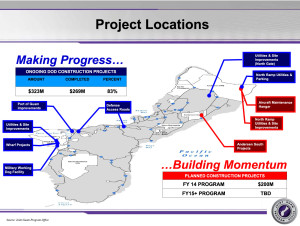



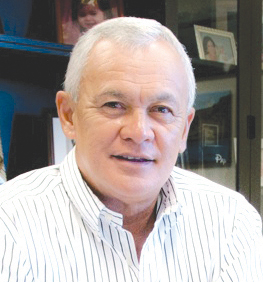
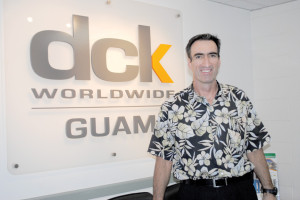
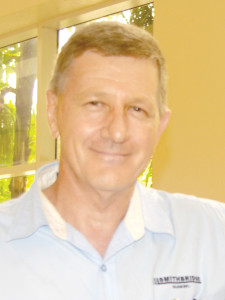

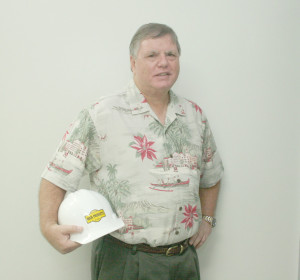












No Responses to “Building confidence: Construction industry gradually on its way back up”